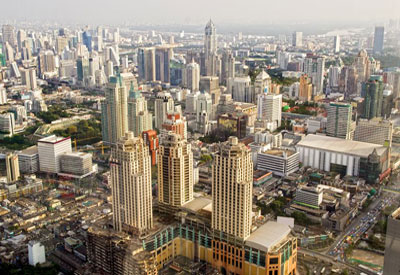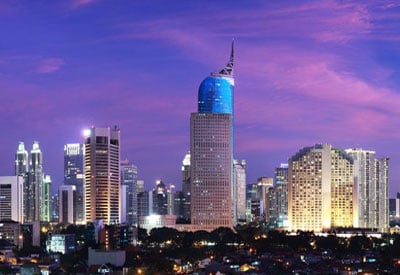Thailand or officially the Kingdom of Thailand is part of Southeast Asia and is almost centrally-located. Thailand has faced several financial and economic crises as well as numerous political upheavals. Overcoming all these crises, Thailand has made significant development success, having made inroads into poverty reduction and strong economic growth.
Thailand is a kingdom with a constitutional monarchy ruled by King Rama IX or King Bhumibol Adulyadej, who has been reigning since 1946, the longest reign in the history of Thailand. Thailand is the 50th largest country in the world in terms of total land area and ranks 21st in the world in terms of population. Bangkok is the largest city and the nation’s capital. And it is the center of the almost all the industrial, commercial, cultural and political activities in Thailand.
Thailand is a mix of traditional and modern practices. It is a hub for shopping and adventure. It is a place where you can see Buddhist monks in saffron-colored robes among people dressed in tropical garments amid people dressed in the latest fashion trends. It has beautiful beaches, colorful floating markets, the mingling odors of different spices and a landscape dotted with various temples, shrines and monuments to their national heroes.
:: Background of Thailand ::
The area occupied by present day Thailand had been inhabited since 40,000 years ago and was eventually influenced by India, religiously and culturally. The first Siamese state prior to the 12th century is the Sukhotai kingdom, a Buddhist one that was founded around 1238. That kingdom was overshadowed by the rise of the kingdom of Ayutthaya that was established in the lower Chao Praya River around the middle of the 14th century.
The leaders of Ayutthaya expanded their territory and started trading with their neighbors and soon it became a major trading center. Progressive leaders started trading with the Portuguese, assimilating some of their culture as well as their knowledge in the process. The French, English and the Dutch also became successful trade partners.
In this Country Profile
Siam was continuously threatened several times by one of its closest neighbor, Burma. And there were many invasions that were launched to rule the progressive Ayutthaya. Eventually Burma was able to conquer Ayutthaya in 1767, although it was short-lived. One of the great leaders of Siam, King Taksin who had led several of the defensive forces who fought against Burmese invasion moved the capital from Ayutthaya which was completely destroyed by the Burmese forces to Thonburi. In 1782, under the reign of Chao Praya Chakri, founder of the House of Chakri when he ascended the throne after the death of King Taksin, the capital was moved to Rattanakosin where Bangkok, the present capital is located. Chao Praya Chakri was later given the title of King Rama I, and his dynasty, the House of Chakri still rules Thailand until today, with King Rama IX one of his descendants.
While the leaders of Thailand imbibed Western influences that contributed to its success economically, politically, socially and educationally, Thailand remained as the only country in Southeast Asia that was never colonized by a European nation.
The absolute monarchy was changed into a constitutional monarchy during a coup in June 1932. In 1939, Siam’s official name was changed to Thailand.
:: Geography of Thailand ::
Thailand holds a major position in Southeast Asia due to its central location. It is the only land road connecting the Asian mainland to Singapore and Malaysia. It is divided into six regions – central, north, northeast, east, west and south regions. Bangkok is considered a separate region, it being the capital and the largest metropolitan area, even if geographically it is part of the central region. Each region is diverse in terms of population, natural features, level of economic and social development and basic resources, making Thailand’s landscape truly unique.
Location
Thailand is located in Southeastern Asia and shares border with Myanmar (Burma) and Laos in the north, Malaysia in the south, the Gulf of Thailand and Cambodia in the east and the Andaman Sea and Myanmar in the west.
Geographic Coordinates
Thailand has a longitude of 100° 00’ East of Greenwich. Its latitude is 15° 00’ North of the Equator.
Area
The country’s total land mass is 513,120 square kilometers with a total land area of 510.890 square kilometers while that covered with water is equivalent to 2,230 square kilometers. In total size, Thailand is more than double the size of Wyoming in the United States.
Land Boundaries
Majority of Thailand is bordered by land. It shares its longest border with Myanmar for 1,800 kilometers. Her border with Laos is 1,754 kilometers long. The Cambodian border runs for 803 kilometers while Thailand’s border with Malaysia is 506 kilometers long.
Coastline
Thailand’s coastline runs for a total of 3,219 kilometers along the Andaman Sea in the west and the Gulf of Thailand in the east. It has a maritime claim of 12 nautical miles of territorial sea with an exclusive economic zone of 200 nautical miles. Its continental shelf is up to a depth of 200 meters.
Climate
Thailand can be hot and humid, typical of a tropical climate. The country is affected by an annual monsoon and has three seasons. It is cool from November up to February or March. The weather turns hot and humid in April and May and rainy season starts in June up to October. The average temperature is between 75° F to 92° F.
Terrain
The central area of Thailand has lowland plains. In the east is the Khorat Plateau. Elsewhere the terrain is mountainous. The highest point in Thailand is Doi Inthanon which rises to 2,576 meters while the lowest point is the Gulf of Thailand.
Natural Resources
Thailand has arable land and is rich in tin, rubber, tantalum, tungsten, natural gas, gypsum, lead, fluorite and lignite. It is also rich in timber and fish.
Land Use
Twenty-seven and a half percent of the total land area is arable while 6.93% is planted with permanent crops. The rest of the land or about 65.53% is used for industry, infrastructure and residential and other land projects.
Natural Hazards
Bangkok is the most popular city in Thailand. It is also the capital city and very highly urbanized. Right now Thailand faces the problem of Bangkok slowly sinking, which in turn depletes the water table. Droughts are also a threat to Thailand.
Environment Issues
Current environment issues that affect Thailand include water pollution contributed by the numerous factory and organic wastes. It also faces air pollution mostly coming from vehicles. There is also the threat to its wildlife population that is slowly getting depleted due to illegal hunting. Added to that are soil erosion and deforestation.
International Agreements
Thailand has entered into international environment agreements pertaining to climate change and climate change-Kyoto Protocol. It is also taking part in agreements for biodiversity, desertification, ozone layer protection, endangered species, and marine life conservation and also in tropical timber 83 and 94, as well as wetlands and hazardous wastes issues. Thailand has already signed but is yet to ratify the law of the sea agreement.
:: People of Thailand ::
Population
As of July 2011 estimates, the population of Thailand is now 66,720,153. This population figure is highly affected by the high mortality rate due the AIDS that have likewise affected the death rates, infant mortality rate, life expectancy, population growth and distribution in population by sex and age.
Age Structure
Currently the age structure is Thailand is mixed. In the 0-14 age group, there is slightly more males than females, with 19.9% broken down into 6,779,732 males compared to 6,466,625 females. In the 15-64 age bracket which represents 70.9% of the population, the disparity is very slight, with 23,410,091 males and 23,913,499 females. In the 65 years and over age group representing 9.2% of the population, there is a shift, with 3,372,203 females to 2,778,012 males, based on 2011 estimates.
Median Age
Overall, the median age in Thailand is 34.2 years, with the male average placed at 33.3 years while that of the female, according to 2011 estimates is placed at 35.2 years.
Population Growth Rate
Thailand’s population growth rate is quite low, only 0.566% according to 2011 estimates.
It is also estimated that the birth rate is 12.395 births for every 1,000 population while the death rate is 7.29. Net migration in Thailand is currently zero based on 2011 estimates. The current fertility rate in Thailand is 1.66 children born for every woman of child-bearing age based on 201 estimates.
Sex Ratio
Out of the total population the sex ratio is 0.98 male for every female. At birth it is 1.054 male for every female, almost maintained through the different age groups. In the under 15 age group, there is 1.05 male for every female, lowered to 0.98 male for every female in the 15-64 age group and still slightly lower at 0.82 male for every female in the 65 years and over age group.
Infant Mortality Rate
On the average the total infant mortality rate in Thailand is high at 16.39 deaths per 1,000 live births. The ratio is slightly higher for the males with 17.38 deaths for every 1,000 live births while it is only 15.35 deaths for every 1,000 live births for females.
Life Expectancy at Birth
For the total population life expectancy at birth is about 73.6 years with the females edging the males slightly with an average of 76.08 years while it is only 71.24 years for the males.
HIV/AIDS
HIV/AIDS is getting to be a major social and health issue in Thailand, it being a major tourist destination by Asians and tourists from other countries around the world. According to the estimates done in 2009, the adult prevalence of HIV/AIDS in Thailand is 1.3%, with a total of 530,000 people living with HIV/AIDS and resulting to deaths to 28,000 people.
Nationality
Thai is a noun that is used in singular and plural form and Thai is also the word used as an adjective to describe a person from Thailand.
Ethnic Groups
Thailand is one of the few countries that were not dominated or ruled by any European country and its ethnic groups are limited. Seventy-five percent of the population is Thai, while 14% is Chinese. The other 11% comprise minor ethnic groups that have made Thailand their home.
Religions
Buddhism is the major religion practiced by 94.6% of the population of Thailand. There is also about 4.6% that follow the Muslim faith while 0.7% practices Christianity and a very minor 0.1% of the population follows other religions, according to the census done in 2000.
Languages
Thai is the dominant language that is spoken in Thailand while English is the secondary language and mainly spoken by the elite. Other ethnic ad regional dialects are also spoken.
Literacy
Literacy in Thailand is very high, placed at 923.6% of the population, with those 15 years and over being able to read and write. For the males, literary is about 94.9% while it is slightly lower for the females at 90.35%. Overall, the Thai people stay in school for 12 years, almost even between the males and the females.
:: References ::
http://www.tourismthailand.org/about-thailand/fast-facts/
http://en.wikipedia.org/wiki/Thailand
https://www.cia.gov/library/publications/the-world-factbook/geos/th.html
http://www.nationsencyclopedia.com/economies/Asia-and-the-Pacific/Thailand.html
http://www.worldbank.or.th


Sorry, the comment form is closed at this time.